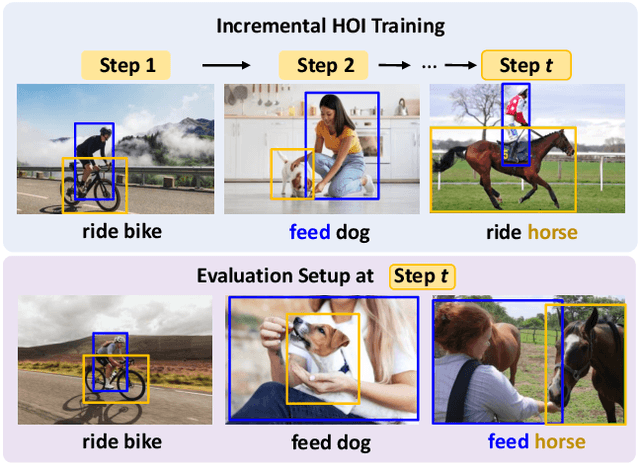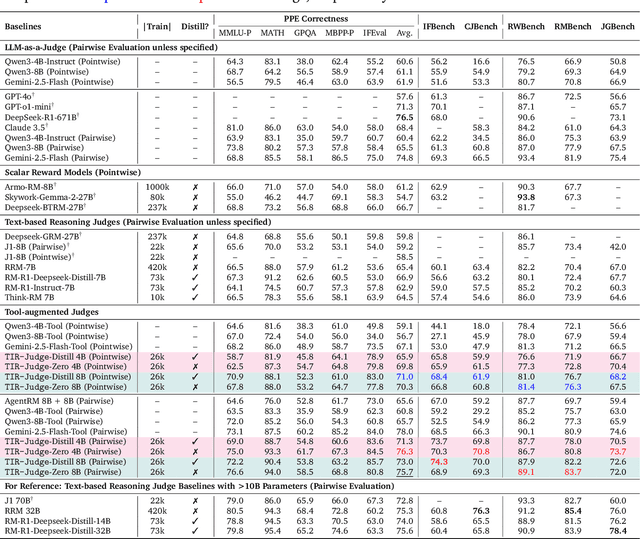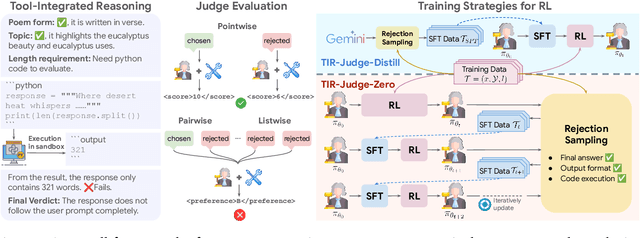Yu Wu
Wuhan University
Text-based Aerial-Ground Person Retrieval
Nov 11, 2025Abstract:This work introduces Text-based Aerial-Ground Person Retrieval (TAG-PR), which aims to retrieve person images from heterogeneous aerial and ground views with textual descriptions. Unlike traditional Text-based Person Retrieval (T-PR), which focuses solely on ground-view images, TAG-PR introduces greater practical significance and presents unique challenges due to the large viewpoint discrepancy across images. To support this task, we contribute: (1) TAG-PEDES dataset, constructed from public benchmarks with automatically generated textual descriptions, enhanced by a diversified text generation paradigm to ensure robustness under view heterogeneity; and (2) TAG-CLIP, a novel retrieval framework that addresses view heterogeneity through a hierarchically-routed mixture of experts module to learn view-specific and view-agnostic features and a viewpoint decoupling strategy to decouple view-specific features for better cross-modal alignment. We evaluate the effectiveness of TAG-CLIP on both the proposed TAG-PEDES dataset and existing T-PR benchmarks. The dataset and code are available at https://github.com/Flame-Chasers/TAG-PR.
Incremental Human-Object Interaction Detection with Invariant Relation Representation Learning
Oct 30, 2025



Abstract:In open-world environments, human-object interactions (HOIs) evolve continuously, challenging conventional closed-world HOI detection models. Inspired by humans' ability to progressively acquire knowledge, we explore incremental HOI detection (IHOID) to develop agents capable of discerning human-object relations in such dynamic environments. This setup confronts not only the common issue of catastrophic forgetting in incremental learning but also distinct challenges posed by interaction drift and detecting zero-shot HOI combinations with sequentially arriving data. Therefore, we propose a novel exemplar-free incremental relation distillation (IRD) framework. IRD decouples the learning of objects and relations, and introduces two unique distillation losses for learning invariant relation features across different HOI combinations that share the same relation. Extensive experiments on HICO-DET and V-COCO datasets demonstrate the superiority of our method over state-of-the-art baselines in mitigating forgetting, strengthening robustness against interaction drift, and generalization on zero-shot HOIs. Code is available at \href{https://github.com/weiyana/ContinualHOI}{this HTTP URL}
Incentivizing Agentic Reasoning in LLM Judges via Tool-Integrated Reinforcement Learning
Oct 27, 2025



Abstract:Large Language Models (LLMs) are widely used as judges to evaluate response quality, providing a scalable alternative to human evaluation. However, most LLM judges operate solely on intrinsic text-based reasoning, limiting their ability to verify complex constraints or perform accurate computation. Motivated by the success of tool-integrated reasoning (TIR) in numerous tasks, we propose TIR-Judge, an end-to-end RL framework for training LLM judges that integrates a code executor for precise evaluation. TIR-Judge is built on three principles: (i) diverse training across verifiable and non-verifiable domains, (ii) flexible judgment formats (pointwise, pairwise, listwise), and (iii) iterative RL that bootstraps directly from the initial model without distillation. On seven public benchmarks, TIR-Judge surpasses strong reasoning-based judges by up to 6.4% (pointwise) and 7.7% (pairwise), and achieves listwise performance comparable to Claude-Opus-4 despite having only 8B parameters. Remarkably, TIR-Judge-Zero - trained entirely without distilled judge trajectories, matches the performance of distilled variants, demonstrating that tool-augmented judges can self-evolve through iterative reinforcement learning.
Rethinking Query-based Transformer for Continual Image Segmentation
Jul 10, 2025Abstract:Class-incremental/Continual image segmentation (CIS) aims to train an image segmenter in stages, where the set of available categories differs at each stage. To leverage the built-in objectness of query-based transformers, which mitigates catastrophic forgetting of mask proposals, current methods often decouple mask generation from the continual learning process. This study, however, identifies two key issues with decoupled frameworks: loss of plasticity and heavy reliance on input data order. To address these, we conduct an in-depth investigation of the built-in objectness and find that highly aggregated image features provide a shortcut for queries to generate masks through simple feature alignment. Based on this, we propose SimCIS, a simple yet powerful baseline for CIS. Its core idea is to directly select image features for query assignment, ensuring "perfect alignment" to preserve objectness, while simultaneously allowing queries to select new classes to promote plasticity. To further combat catastrophic forgetting of categories, we introduce cross-stage consistency in selection and an innovative "visual query"-based replay mechanism. Experiments demonstrate that SimCIS consistently outperforms state-of-the-art methods across various segmentation tasks, settings, splits, and input data orders. All models and codes will be made publicly available at https://github.com/SooLab/SimCIS.
Adaptive Part Learning for Fine-Grained Generalized Category Discovery: A Plug-and-Play Enhancement
Jul 09, 2025Abstract:Generalized Category Discovery (GCD) aims to recognize unlabeled images from known and novel classes by distinguishing novel classes from known ones, while also transferring knowledge from another set of labeled images with known classes. Existing GCD methods rely on self-supervised vision transformers such as DINO for representation learning. However, focusing solely on the global representation of the DINO CLS token introduces an inherent trade-off between discriminability and generalization. In this paper, we introduce an adaptive part discovery and learning method, called APL, which generates consistent object parts and their correspondences across different similar images using a set of shared learnable part queries and DINO part priors, without requiring any additional annotations. More importantly, we propose a novel all-min contrastive loss to learn discriminative yet generalizable part representation, which adaptively highlights discriminative object parts to distinguish similar categories for enhanced discriminability while simultaneously sharing other parts to facilitate knowledge transfer for improved generalization. Our APL can easily be incorporated into different GCD frameworks by replacing their CLS token feature with our part representations, showing significant enhancements on fine-grained datasets.
Spotlighting Partially Visible Cinematic Language for Video-to-Audio Generation via Self-distillation
Jul 03, 2025Abstract:Video-to-Audio (V2A) Generation achieves significant progress and plays a crucial role in film and video post-production. However, current methods overlook the cinematic language, a critical component of artistic expression in filmmaking. As a result, their performance deteriorates in scenarios where Foley targets are only partially visible. To address this challenge, we propose a simple self-distillation approach to extend V2A models to cinematic language scenarios. By simulating the cinematic language variations, the student model learns to align the video features of training pairs with the same audio-visual correspondences, enabling it to effectively capture the associations between sounds and partial visual information. Our method not only achieves impressive improvements under partial visibility across all evaluation metrics, but also enhances performance on the large-scale V2A dataset, VGGSound.
BNMusic: Blending Environmental Noises into Personalized Music
Jun 12, 2025Abstract:While being disturbed by environmental noises, the acoustic masking technique is a conventional way to reduce the annoyance in audio engineering that seeks to cover up the noises with other dominant yet less intrusive sounds. However, misalignment between the dominant sound and the noise-such as mismatched downbeats-often requires an excessive volume increase to achieve effective masking. Motivated by recent advances in cross-modal generation, in this work, we introduce an alternative method to acoustic masking, aiming to reduce the noticeability of environmental noises by blending them into personalized music generated based on user-provided text prompts. Following the paradigm of music generation using mel-spectrogram representations, we propose a Blending Noises into Personalized Music (BNMusic) framework with two key stages. The first stage synthesizes a complete piece of music in a mel-spectrogram representation that encapsulates the musical essence of the noise. In the second stage, we adaptively amplify the generated music segment to further reduce noise perception and enhance the blending effectiveness, while preserving auditory quality. Our experiments with comprehensive evaluations on MusicBench, EPIC-SOUNDS, and ESC-50 demonstrate the effectiveness of our framework, highlighting the ability to blend environmental noise with rhythmically aligned, adaptively amplified, and enjoyable music segments, minimizing the noticeability of the noise, thereby improving overall acoustic experiences.
Inference-Time Scaling for Generalist Reward Modeling
Apr 03, 2025Abstract:Reinforcement learning (RL) has been widely adopted in post-training for large language models (LLMs) at scale. Recently, the incentivization of reasoning capabilities in LLMs from RL indicates that $\textit{proper learning methods could enable effective inference-time scalability}$. A key challenge of RL is to obtain accurate reward signals for LLMs in various domains beyond verifiable questions or artificial rules. In this work, we investigate how to improve reward modeling (RM) with more inference compute for general queries, i.e. the $\textbf{inference-time scalability of generalist RM}$, and further, how to improve the effectiveness of performance-compute scaling with proper learning methods. For the RM approach, we adopt pointwise generative reward modeling (GRM) to enable flexibility for different input types and potential for inference-time scaling. For the learning method, we propose Self-Principled Critique Tuning (SPCT) to foster scalable reward generation behaviors in GRMs through online RL, to generate principles adaptively and critiques accurately, resulting in $\textbf{DeepSeek-GRM}$ models. Furthermore, for effective inference-time scaling, we use parallel sampling to expand compute usage, and introduce a meta RM to guide voting process for better scaling performance. Empirically, we show that SPCT significantly improves the quality and scalability of GRMs, outperforming existing methods and models in various RM benchmarks without severe biases, and could achieve better performance compared to training-time scaling. DeepSeek-GRM still meets challenges in some tasks, which we believe can be addressed by future efforts in generalist reward systems. The models will be released and open-sourced.
Implicit Bias Injection Attacks against Text-to-Image Diffusion Models
Apr 02, 2025



Abstract:The proliferation of text-to-image diffusion models (T2I DMs) has led to an increased presence of AI-generated images in daily life. However, biased T2I models can generate content with specific tendencies, potentially influencing people's perceptions. Intentional exploitation of these biases risks conveying misleading information to the public. Current research on bias primarily addresses explicit biases with recognizable visual patterns, such as skin color and gender. This paper introduces a novel form of implicit bias that lacks explicit visual features but can manifest in diverse ways across various semantic contexts. This subtle and versatile nature makes this bias challenging to detect, easy to propagate, and adaptable to a wide range of scenarios. We further propose an implicit bias injection attack framework (IBI-Attacks) against T2I diffusion models by precomputing a general bias direction in the prompt embedding space and adaptively adjusting it based on different inputs. Our attack module can be seamlessly integrated into pre-trained diffusion models in a plug-and-play manner without direct manipulation of user input or model retraining. Extensive experiments validate the effectiveness of our scheme in introducing bias through subtle and diverse modifications while preserving the original semantics. The strong concealment and transferability of our attack across various scenarios further underscore the significance of our approach. Code is available at https://github.com/Hannah1102/IBI-attacks.
Revisiting Classification Taxonomy for Grammatical Errors
Feb 18, 2025Abstract:Grammatical error classification plays a crucial role in language learning systems, but existing classification taxonomies often lack rigorous validation, leading to inconsistencies and unreliable feedback. In this paper, we revisit previous classification taxonomies for grammatical errors by introducing a systematic and qualitative evaluation framework. Our approach examines four aspects of a taxonomy, i.e., exclusivity, coverage, balance, and usability. Then, we construct a high-quality grammatical error classification dataset annotated with multiple classification taxonomies and evaluate them grounding on our proposed evaluation framework. Our experiments reveal the drawbacks of existing taxonomies. Our contributions aim to improve the precision and effectiveness of error analysis, providing more understandable and actionable feedback for language learners.
 Add to Chrome
Add to Chrome Add to Firefox
Add to Firefox Add to Edge
Add to Edge